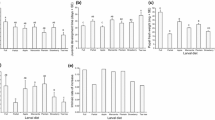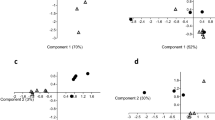Abstract
Plant-mediated egg mortality varied greatly for the oligophagous leafhopper, Carneocephala floridana, a common inhabitant of the salt marshes along Florida's Gulf coast. In the laboratory, survivorship from egg to first instar was generally greater on two herbaceous plants. Borrichia frutescens and Salicornia virginica (80 and 81% respectively) than it was on two grasses, Distichlis spicata and Spartina alterniflora (41 and 77% respectively). Although C. floridana laid significantly more eggs per clutch on Sp. alterniflora than on the two herbaceous species, this increase in egg number was offset by the higher mortality of eggs laid on this species. The greatest source of identifiable plant-mediated egg mortality was death due to desiccation of the leaf tissue surrounding the egg clutch. In addition, field experiments in which the four host species were infested with eggs of C. floridana at natural densities consistently yielded higher parasitism rates by two mymarid wasps on the grasses, regardless of the background plants. C. floridana switches host plants seasonally, using the grass species mainly during the winter months, when the herbaceous species experience a substantial dieback. The herbaceous species are nutritionally superior to the two grass species as a food source for C. floridana. C. floridana reared on the herbs produce larger, more fecund, adults than they do on the grasses (Rossi 1991). However, during cold winter snaps the grasses, while less “attractive”, may provide the most abundant nutritional and ovipositional resources available to C. floridana. The results of this study indicate how variable rates of plant-and parasitoid-mediated egg mortality may work synergistically with the interspecific nutritional status of the plants to explain host switching for this insect.
Similar content being viewed by others
References
Atsatt PR (1981) Lycaenid butterflies and ants: selection for enemy free space. Am Nat 118:638–654
Barbosa P (1988) Natural enemies and herbivore-plant interactions: influence of plant allelochemicals and host specificity. In: Barbosa P, Letourneau DK (eds) Novel aspects of plant-insect interactions. Wiley, New York, pp 201–229
Cook AG, Perfect TJ (1989) The population characteristics of the brown planthopper, Nilaparvata lugens, in the Phillipines. Ecol Entomol 14:1–9
Dempster JP (1983) The natural control of populations of butterflies and moths. Biol Rev 58:461–481
Duncan WH, Duncan MB (1987) Seaside plants of the gulf and atlantic coasts. Smithsonian Institution Press, Washington
Eller FJ, Tumlinson JH, Lewis WJ (1988) Beneficial arthropod behavior mediated by airborne semiochemicals. II. Olfactorometric studies of host location by the parasitoid Microplitis croceipes (Cresson) (Hymenoptera: Braconidae). J Chem Ecol 14:425–434
Futuyma DJ, Moreno G (1988) The evolution of ecological specialization. Annu Rev Ecol Syst 19:207–233
Holt RD (1984) Spatial heterogeneity, indirect interactions, and the coexistence of prey species. Am Nat 124:377–406
Kiritani K, Nobuhiko H, Sasaba T, Nakasuji F (1970) Studies on population dynamics of the green rice leafhopper, Nephotettix cincticeps Uhler: regulatory mechanism of the population density. Res Popul Ecol 12:137–153
Lawton JH (1986) The effect of parasitoids on phytophagous insect communities. In: Waage J, Greathead D (eds) Insect Parasitoids. Academic Press, London, pp 265–287
Monteith LG (1960) Influence of plants other than the food of their host on host-finding by tachinid parasites. Can Entomol 92:641–652
Naranjo SE, Stimac JL (1987) Plant influences on predation and oviposition by Geocoris punctipes (Hemiptera: Lygaeidae) in soybeans. Environ Entomol 16:182–189
Noldus LPJJ, Lenteren JC van (1985) Karimones for the egg parasite Trichogramma evanescens Westwood I. Effect of volatile substances released by two of its host, Pieris brassicae and Mamestra brassicae L. J Chem Ecol 11:781–791
Nordlund DA (1987) Plant produced allelochemicals and their involvement in the host selection behavior of parasitoids. In: Labeyrie V, Fabres G, Lachaise D (eds) Plants-insects. Junk, Dordrecht, pp 103–107
Price PW, Clancy KM (1986) Interactions among three trophic levels: galls size and parasitoid attack. Ecology 67:1593–1600
Price PW, Bouton CE, Gross P, McPheron BA, Thompson JN, Weis AE (1980) Interactions among three trophic levels: influence of plants on interactions between insect herbivores and natural enemies. Annu Rev Ecol Syst 11:41–65
Thoades DF (1979) Evolution of plant chemical defense against herbivores. In: Rosenthal CA, Janzen DH (eds) Herbivores: their interaction with secondary plant metabolites. Academic Press, New York, pp 3–54
Rossi AM (1991) The factors influencing host plant preference and performance of the leafhopper Carneocephala floridana (Homoptera: Cicadellidae). Ph. D. Dissertation, Florida State University Tallahassee
Rossi AM, Strong DR (1990) Natural history of the leafhopper Carneocephala floridana (Homoptera: Cicadellidae) in a north Florida salt marsh. Fla Entomol 73:147–153
Rossi AM, Strong DR (1991) Effects of host-plant nitrogen on the preference and performance of laboratory populations of Carneocephala floridana (Homoptera: Cicadellidae). Environ Entomol 20:1349–1355
Rossi AM, Stiling PD, Strong DR, Johnson DM (1992) Does gall diameter affect the parasitism rate of Asphondylia borrichiae (Diptera: Cecidomyiidae)? Ecol Entomol 17:149–154
Rotheray GE (1981) Host searching and oviposition behavior of some parasitoids of aphidophagous Syrphidae. Ecol Entomol 6:79–87
Sasaba T, Kiritani K (1972) Evaluation of mortality factors with special reference to parasitism of the green rice leafhopper Nephotettix cincticeps (Hemiptera: Deltocephalidae). Appl Entomol Zool 7:83–93
Simms EL, Fritz RS (1990) The ecology and evolution of host-plant resistance to insects. Trends Ecol Evol 5:356–360
Stiling PD (1980) Host plant specificity, oviposition behavior and egg parasitism in some leafhoppers of the genus Eupteryx (Hemiptera: Cicadellidae). Ecol Entomol 5:79–85
Stiling PD, Strong DR (1982) Egg density and the intensity of parasitism in Prokelisia marginata (Homoptera: Delphacidae). Ecology 63:1630–1635
Stiling P, Rossi AM, Strong Dr, Johnson DM (1992) Life history and parasites of Asphondylia borrichiae (Diptera: Cecidomyiidae), a gall maker on Borrichia frutescens. Fla Entomol 75:130–137
Thompson JN (1988) Evolutionary ecology of the relationship between oviposition preference and performance of the offspring in phytophagous insects. Entomol Exp Appl 47:3–14
Turlings TC, Tumlinson JH, Lewis WJ, Vet LEM (1989) Beneficial arthropod behavior mediated by airborne semiochemicals. VIII. Learning of host-related odors induced by a brief contact experience with host by-products in Cotesia marginiventris (Cresson), a generalist larval parasitoid. J Insect Behav 2:217–225
Vinson SB (1976) Host selection by insect parasitoids. Annu Rev Entomol 21:109–131
Vinson SB (1981) Habitat location. In: Nordlund DA, Jones RL, Lewis WJ (eds) Semiochemicals: their role in pest control. Wiley, New York, pp 51–77
Vinson SB, Elzen GW, Williams HJ (1987) The influence of volatile plant allelochemicals on the third trophic level (parasitoids) and their herbivorous hosts. In: Labeyrie V, Fabres G, Lachaise D (ed)) Insects-plants. Junk, Dordrecht, pp (pp109-114)
Author information
Authors and Affiliations
Rights and permissions
About this article
Cite this article
Rossi, A.M., Reeve, J.D. & Cronin, J.T. The effect of plant- and parasitoid-induced egg mortality on the interspecific distribution of an oligophagous herbivore. Oecologia 100, 89–93 (1994). https://doi.org/10.1007/BF00317134
Received:
Accepted:
Issue Date:
DOI: https://doi.org/10.1007/BF00317134




